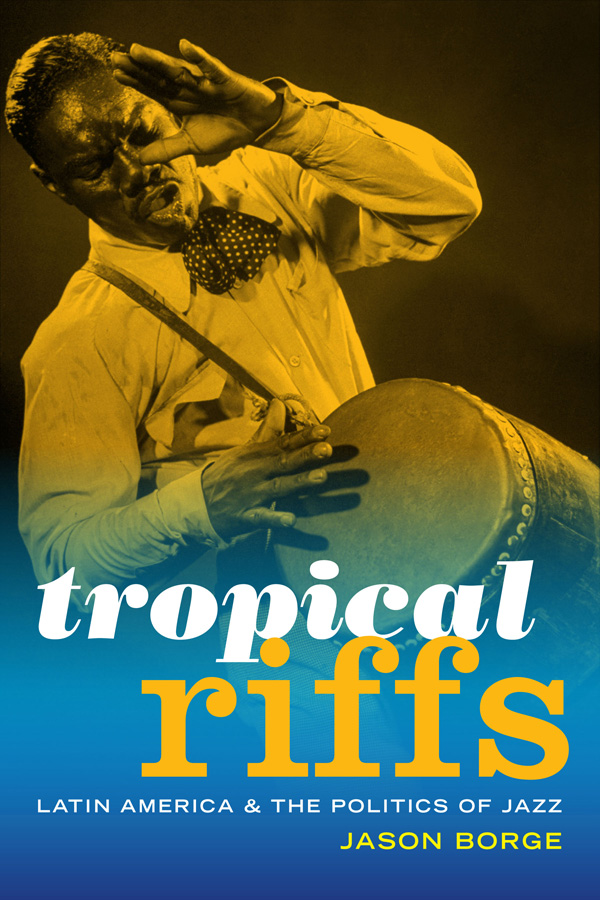Tropical Riffs: Latin America and the Politics of Jazz. By Jason Borge. Durham: Duke University Press, 2018. 280pp. Paperback. US$25.95 978-0-8223-6990-5

In most academic and non-academic discourses surrounding Jazz, audiences are often reminded that jazz is an American (as in U.S. American) art form. Though not always explicit, the implication seems to be that as an American art form, it has been exclusively U.S.-owned. In Tropical Riffs, Jason Borge attempts a decentered and expansive notion of what constitutes jazz discourse and criticism (7). By exploring the politics of jazz in several countries of Latin America, Borges shows how some countries in Latin America did not just “embrace and repudiate, consume and purge, imitate and appropriate jazz,” rather how “the region and its musicians actively participated in the global jazz enterprise” (3). Connections between Latin American music and jazz abound, often taking Latin America as a peripheral phenomenon. Borge considers “not what Latin America meant to the U.S. jazz establishment so much as what jazz meant to Latin America” (vii). Along these lines, he embarks on the titanic enterprise of decoding what jazz meant in Argentina, Brazil, Mexico, and Cuba between 1920 and 1960 by taking an approach that considers literature, film studies, and ethnomusicology, among other disciplines. By combining these, the author accomplishes the difficult task of constructing an interesting argument based on news clips, films, poetry, literature, and ethnomusicological theory. The book is divided into five chapters: the first provides an overview of jazz in several countries of Latin America and unveils the diverse, sometimes contrasting reactions towards jazz by exploring the work of visual artist Miguel Covarrubias and singer-actress Josephine Baker. In this chapter, the author considers the importance of Europe’s intellectuals and musicians in “disinfecting Afro-descendant music and dance” (22). Chapter two explores jazz in Argentina and highlights not only issues of race, but social class and musical national identity. It juxtaposes interesting literary fiction by Julio Cortázar with the work of musicians Oscar Alemán, Lalo Shifrin, and Leandro “Gato” Barbieri, among many others. Jazz in Brazil, and especially its connections with political unrest, forms the topic of chapter three, where the reader encounters the usual suspects: Tom Jobim, Joao Gilberto, and Stan Getz; Borge also devotes attention, however, to pianist and singer Dick Farney. This exploration allows the author to highlight the ambivalent reaction between audiences and critics (i.e. Tinhorāo), who compares “bossanovistas to mixed-race ‘bastards’ from the favelas” (123). Chapter four focuses on Cuban music and musicians who had an outsize impact on the nascent music industry, and it constitutes, perhaps, the core argument for jazz as a transnational music. Departing from previous chapters, Cuban musical production is assessed as an exogenous musical phenomenon that contributed to a transnational musical circuit. In chapter five the author assesses the political and musical reconfiguration of jazz throughout the world, considering the influence of the U.S. State Department and the appearance of new jazz figures with new musical ideas. The author also weighs the impact of jazz in Latin America as musical symbol and the cultural capital it provides during the second half of the twentieth century by assessing the works of poets, cultural critics, and writers.
Tropical Riffs is a useful history of jazz in America (broadly speaking) that weaves fiction, history, poetry, and theory. Throughout the book it becomes apparent that even the term “Latin America” is insufficient to account for music mobility; however, Borge unveils connections between Jazz and Latin America often missed by compartmentalized methodologies, such as the influence of jazz in Latin American Literature or jazz in Latin American visual arts. Paradoxically, in his attempt to decentralize jazz discourse, which often is driven by racial and social tensions in the U.S., Borge unveils the racial and social tensions within Latin America which surfaced in jazz. The book is beautifully written and researched. It is clear throughout the book that the author understands the diversity within Latin America, however, the unfortunate use of “tropical” in the title to refer to Latin America lends a traditional, essentialist, and obsolete view of Latin America, one that “tropicalizes” decidedly un-tropical cities such as Mexico City and Buenos Aires. There is no question in this reader’s mind that this is an excellent approximation of what jazz meant to some audiences and critics in some Latin American countries. The book that effectively unveils what jazz meant in a vast and diverse region of the world between 1920-1960 would by necessity reach encyclopedic length; such a book awaits an author up to the monumental task. Until then, Tropical Riffs provides a solid introduction to what jazz meant to Latin Americans during the decades in question.